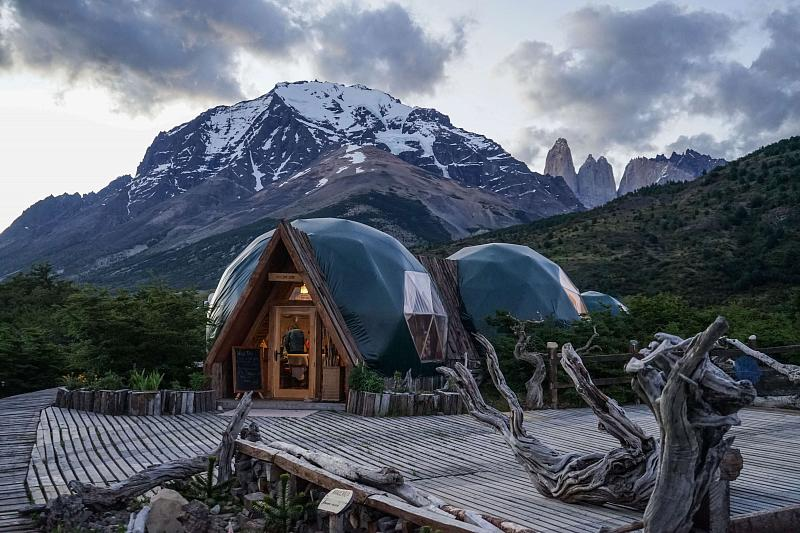Glamping is a mix of "glamour" and "camping". It is a form of camping with more luxurious facilities than traditional ones. This is a way to make camping more comfortable and approachable.
The global glamping market size was valued at $1.88 billion in 2020. It is expected to expand at an annual growth rate of 14%.
This article focuses on the stages of setting up a glamping business.
Step 1: Plan the business
As with any hospitality business, research is a key factor of success. We have done some for you.
Target market
Your market dictates what kind of accommodation, facilities, and even location you offer.
Travelers you can target:
- Families: they look for larger accommodations and entertainment for children
- Couples: they need privacy and romantic extras, although they do not require as much space as families
- Luxury market: they need high-quality facilities and meal services
- Budget market: they often look for simpler furnishing with the option for self-cater
- Pet-friendly: provide them with such inexpensive extras as dog bowls or treats
- Eco-friendly: offer facilities for recycling and choose sustainable materials for construction
According to reports, half of all glampers are millennials with children. Most glampers take at least 10 trips annually, so they are looking for a travel experience in unique destinations. This should influence your choice of the glamping site.
Glamping site
If you already own some land, think of what makes it attractive for guests and emphasize this feature. If you do not have any land, do research and find out what is missing from the local area. For example, this might be a much-needed accommodation near some natural tourist attraction.
When choosing the location, look for something:
- Away from traffic/other noise
- Easy to reach & with enough parking space
- Well-drained and flat to put up tents
- Appealing to guests
 This is how glamping owners solved privacy issues.
This is how glamping owners solved privacy issues.
Cost of entry
Considering the points above, work out your set-up and operational costs.
The key expenses are the following:
- Purchasing land and tents and their maintenance
- Installing electricity, sanitary, and waste disposal facilities
- Furnishing, lighting, heating, and linen
- Extras set-up and maintenance
- Marketing cost
Minimal cost of tents varies from $1.600 to $10.000. Choose the ones that will meet the requirements of your target market and your budget.
How to count your income
Let’s assume that one tent costs $1.600, its furnishing is $1.500, and its amenities are $500. Depending on the climate in the area and the duration of the peak camping season there, calculate the average number of nights booked. In our case, it is about 55. Let’s set the average rate for such accommodation at $125 per night.
Average investment per tent: $3.600
Gross revenue: $125 x 55 = $6.875
Gross income per tent for a season: $3.275
You can start small for the first season by purchasing 3 tents. Grow from there, as your gross earnings for the second season will be higher, considering that you will not need to buy tents again and refurbish them.
Step 2: Obtain permissions
Find out about permissions needed to set up a business like glamping in your country. Every country has its own health and safety regulations and ways to get planning permissions. Approach your local authority or council to specify the things to do. The whole procedure might take from 6 months to 2 years.
Possible steps to follow (depending on your country):
- Establish a legal entity
- Register for taxes
- Open a business bank account/get a business credit card
- Set up business accounting
- Get business insurance
Step 3: Set up & furnish tents
Think about what your site will look like. Decide how many structures you will have and wh ere you will put toilet and shower blocks. Consider communal areas and how they will meet the needs of your target audience.
Find a glamping site location
Select a flat, private and picturesque location to put up tents. Keep the distance from trees to make it easier for you to maintain cleanliness. Choose spots from which water drains away well to avoid mud and puddles. Make sure the glamping backyard will be appealing so that your guests take more pictures of the place.
 Create a communal area with sitting space, a fire pit, and tables.
Create a communal area with sitting space, a fire pit, and tables.
Choose a glamping structure to put up
Pick something that complements your site, style, and budget. Popular options are the following:
- Bell tents
- Bubble domes
- Shepherd hut
- Tree houses
- Safari tents
- Glamping pods
- Tepees
- Yurts
Set up tents
Trim back grass, plants, and branches at spots wh ere you want to put up tents. It would be best to level the ground with the shovel and remove anything sharp from the ground as well.
Whether or not you will be able to set up a tent on your own depends on the type of structure. You will certainly need assistance to put up complex ones. Here is how to do this with a Bell Tent.
Furnish and decorate
Pick a design style first. It might be boho chic, country-western, rustic, elegant, modern, shabby chic, or anything else of your choice.
Decide on how many guests you want to welcome in each tent. Depending on the size of the structure, a tent can hold up to 2 king-size beds or 4 single beds. Place the number of beds that will meet the needs of your target market.
Other important items to buy for furnishing are the following:
- Mattresses/linen/ towels/ blankets/pillows
- Chairs
- Rugs
- Mirrors
- Wastebasket
- Luggage rack/ clothes hanger/ boot tray
- Lights
Power up
Provide guests with electrical power so that they could at least recharge their phones.
Here are some solutions:
- Rechargeable power bank charger
- Rechargeable portable power station
- Extension cord/power strip
You may offer the two first ones as extras to check them in/out and earn some more.
Offer some entertainment options
Add some books, magazines, and board games for rainy days and downtime.
Make a list of local attractions outside the glamping site. Print it out along with shops, experiences, and hikes options as booklets. Place them inside the tent or send them after the booking is made so that guests could plan the trip.
Prepare bathroom facilities
Restrooms are critical for standing out from ordinary campings. When setting up toilets and showers you do not have to get anything extra — provide comfort and privacy.
Popular toilet options are the following:
- Stand-alone plumbed bathroom with running water
- Compost toilet
- "Port-a-Potty"
- RV toilet
Place them closer to tents. If you do not get a sink with running water, provide wet wipes and sanitizer instead.
 Example of making glamping bathroom appealing and private
Example of making glamping bathroom appealing and private
Having a shower available will encourage your guests to stay longer. Options to provide:
- Fully-functioning bathroom
- Propane tankless water heater shower
- Solar shower bag
- Day passes in the local gym, if there is one
For the first three, provide private structures. Partner with a gym for the last one to let your guests have a shower there.
Step 4: Promote and market
Defining your brand mostly means building the online presence. This includes the essentials: glamping website, social media, business listings, and OTAs. For all the mentioned, high-quality pictures are a "must" to capture guests’ attention and make them imagine what it feels like to stay at your glamping.
Glamping website
You do not need tech knowledge to create a website. Entrust a web developer with this or do everything yourself in a website builder. To ensure seamless integration of a booking engine to the website you might need some assistance. There are at least 3 TravelLine website development options. Contact us at manager@travelline.pro to figure out the most suitable one for you.
Business listings
The more people see your business, the more people book a stay. Get listed on the websites wh ere most glampings are: Booking.com, Airbnb and other popular ones. They charge considerable commissions for bookings, so drive more traffic to the website by offering discounts and promo codes.
 Encourage your friends to come and post honest reviews on popular platforms.
Encourage your friends to come and post honest reviews on popular platforms.
Social media
Set up business profiles on social networks that your target market uses. Post professional pictures and reviews. In captions, explain how to get to destinations and when you open. Give a clear Call-to-Action and provide users with the booking link.
You would enjoy running a glamping business if you love connecting with guests and being outdoors. You may start glamping alongside another hospitality business, especially if there is some unused land. Remember that being a glamping host is about making guests feel welcome and helping them to connect with nature.



